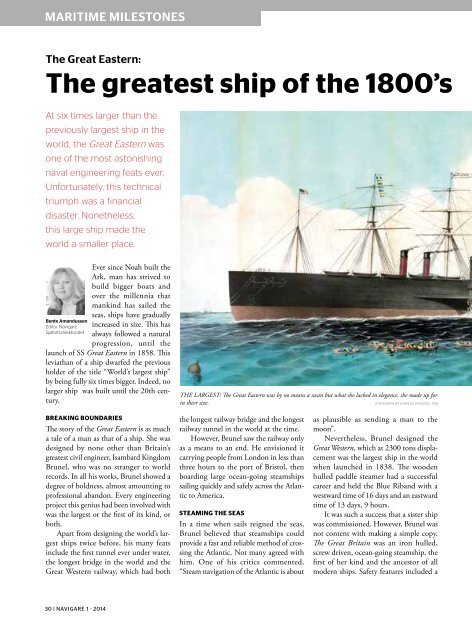You also want an ePaper? Increase the reach of your titles
YUMPU automatically turns print PDFs into web optimized ePapers that Google loves.
maritime milestones<br />
The Great Eastern:<br />
The greatest ship of the 1800’s<br />
At six times larger than the<br />
previously largest ship in the<br />
world, the Great Eastern was<br />
one of the most astonishing<br />
naval engineering feats ever.<br />
Unfortunately, this technical<br />
triumph was a financial<br />
disaster. Nonetheless,<br />
this large ship made the<br />
world a smaller place.<br />
Bente Amandussen<br />
Editor <strong>Navigare</strong><br />
Sjøfartsdirektoratet<br />
Ever since Noah built the<br />
Ark, man has strived to<br />
build bigger boats and<br />
over the millennia that<br />
mankind has sailed the<br />
seas, ships have gradually<br />
increased in size. This has<br />
always followed a natural<br />
progression, until the<br />
launch of SS Great Eastern in 1858. This<br />
leviathan of a ship dwarfed the previous<br />
holder of the title “World’s largest ship”<br />
by being fully six times bigger. Indeed, no<br />
larger ship was built until the 20th century.<br />
THE LARGEST: The Great Eastern was by no means a swan but what she lacked in elegance, she made up for<br />
in sheer size. Lithograph by Charles Parsons, 1858<br />
BREAKING BOUNDARIES<br />
The story of the Great Eastern is as much<br />
a tale of a man as that of a ship. She was<br />
designed by none other than Britain’s<br />
greatest civil engineer, Isambard Kingdom<br />
Brunel, who was no stranger to world<br />
records. In all his works, Brunel showed a<br />
degree of boldness, almost amounting to<br />
professional abandon. Every engineering<br />
project this genius had been involved with<br />
was the largest or the first of its kind, or<br />
both.<br />
Apart from designing the world’s largest<br />
ships twice before, his many feats<br />
include the first tunnel ever under water,<br />
the longest bridge in the world and the<br />
Great Western railway, which had both<br />
the longest railway bridge and the longest<br />
railway tunnel in the world at the time.<br />
However, Brunel saw the railway only<br />
as a means to an end. He envisioned it<br />
carrying people from London in less than<br />
three hours to the port of Bristol, then<br />
boarding large ocean-going steamships<br />
sailing quickly and safely across the Atlantic<br />
to America.<br />
STEAMING THE SEAS<br />
In a time when sails reigned the seas,<br />
Brunel believed that steamships could<br />
provide a fast and reliable method of crossing<br />
the Atlantic. Not many agreed with<br />
him. One of his critics commented,<br />
“Steam navigation of the Atlantic is about<br />
as plausible as sending a man to the<br />
moon”.<br />
Nevertheless, Brunel designed the<br />
Great Western, which at 2300 tons displacement<br />
was the largest ship in the world<br />
when launched in 1838. The wooden<br />
hulled paddle steamer had a successful<br />
career and held the Blue Riband with a<br />
westward time of 16 days and an eastward<br />
time of 13 days, 9 hours.<br />
It was such a success that a sister ship<br />
was commissioned. However, Brunel was<br />
not content with making a simple copy.<br />
The Great Britain was an iron hulled,<br />
screw driven, ocean-going steamship, the<br />
first of her kind and the ancestor of all<br />
modern ships. Safety features included a<br />
30 | <strong>Navigare</strong> 1 - <strong>2014</strong>


















